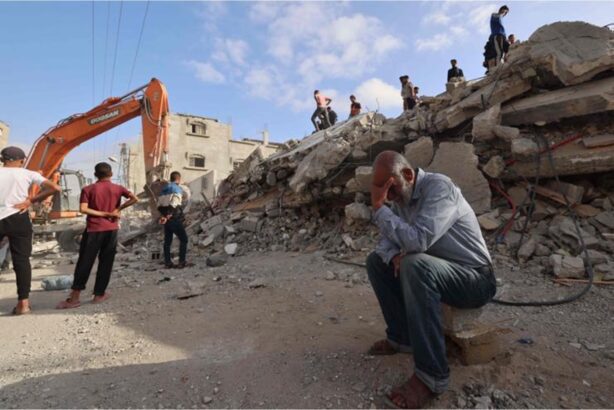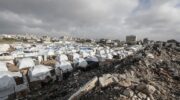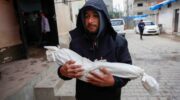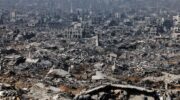fcap]
Another mass grave indicates executions; UN says Israel has been lying about numbers of aid trucks; Israel kills 14 in a massive, 50-hour attack in West Bank; Israel loves the new aid package, denounces the new sanction against one military unit; news about the temporary pier being built for Gaza, more
By IAK staff, from reports
Bodies found in bags marked in Hebrew at destroyed Nasser Hospital
Al Jazeera’s Hani Mahmoud reports from Khan Younis: Horrific scenes after the Israeli military withdrew from Nasser Hospital on April 7, leaving trails of destruction inside the complex. What’s most shocking is the discovery of a mass grave, the largest so far in the city of Khan Younis.
In the hospital courtyard, civil defense members and paramedics have retrieved 180 bodies buried in this mass grave by the Israeli military. The bodies include elderly women, children and young men.
Rescuers say some bodies were found inside plastic bags that have Hebrew writing on them. Some have their hands tied behind their backs and it looks like they were executed and then buried here.
Nasser Hospital is not the first health facility where there are mass graves. Al-Shifa Hospital, just within the past few days, discovered more bodies in the northern part. Kamal Adwan Hospital, two months ago, found more bodies.
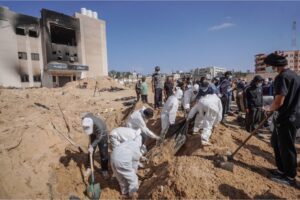
Israeli, US aid truck statistics are ‘a complete lie’: Gaza media office
Al Jazeera reports: The government media office in Gaza says the total number of aid trucks entering the Gaza Strip on a daily basis ranges, on average, between 130 and 150 trucks.
In a press release, the media office said the Israeli “narrative” adopted by the United States that there are around 300 aid trucks entering the Gaza Strip daily “is a complete lie and a falsification of reality”.
The office said that the areas in northern Gaza are still suffering from a real food crisis and that the only way to stop the famine in northern Gaza and address the food crisis across the whole enclave is to open all crossings.
Since the start of April, no more than 2,800 trucks have entered the enclave, according to the media office.
“The occupation deliberately lies about the humanitarian reality inside the Gaza Strip, and has been promoting a false narrative for some time about improvements in the mechanism of bringing aid in and increasing the number of trucks entering the Strip,” the statement read.
“This was denied by the World Food Program, when it announced last Thursday that only 392 aid trucks loaded with food had entered the Gaza Strip during the month of April.
WAFA adds: The United Nations Office for the Coordination of Humanitarian Affairs in (OCHA) reported today that humanitarian convoys have been unable to deliver fuel to hospitals in the Gaza Strip due to Israeli obstacles.
The UN office announced that two-thirds of the coordinated humanitarian missions in Gaza are facing obstacles or delays by Israeli occupation authorities. On average, it said, each mission encountered delays of at least five hours before being allowed to proceed.
As a result, vital supplies, equipment, and fuel for backup generators in hospitals have not been delivered.
“Of those 13 hours, almost six were spent waiting for the green light. So it's these sorts of delays that compromise our efforts almost every day here in Gaza.”
UNICEF's Tess Ingram on the reality of delivering supplies to north Gaza. pic.twitter.com/9haNe60QUE
— UNICEF (@UNICEF) April 19, 2024
West Bank: Israeli forces kill 14 Palestinians in days-long refugee camp assault
Middle East Eye reports: Israeli forces withdrew from a refugee camp in the occupied West Bank on Saturday following a deadly two-day raid likened by Palestinians to the intensity of Second Intifada attacks.
The assault began late on Thursday with Israeli armored vehicles and troops surrounding the Nur Shams refugee camp east of Tulkarm city.
For more than 50 hours, Israeli forces maintained a siege on the camp while they shot at residents, arrested scores of people and destroyed homes.
Palestinians, including those killed and wounded, were trapped inside the camp without access to medical assistance, as ambulances were blocked by Israeli forces.
For two days, the ministry said its staff were unable to enter the camp despite multiple reports of casualties and pleas for help.
On Saturday evening, medical teams and journalists finally reached the affected areas in the camp after Israeli soldiers withdrew.
A total of 14 bodies were recovered by paramedics, including that of a 15-year-old boy. More than 40 people had been wounded.
Some residents described the intensity of the assault as similar to the Israeli incursion during the Second Intifada, or uprising, of 2000 to 2005.
A general strike was announced across the West Bank to mourn the dead, with calls for residents to confront Israeli soldiers at checkpoints.
On Sunday morning, two Palestinians were shot dead near Hebron after allegedly attempting an attack against Israeli soldiers.

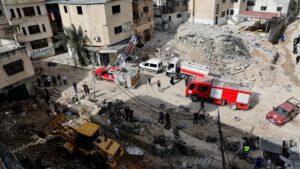
WHAT’S IN THE $95 BILLION FOREIGN AID PACKAGE PASSED BY THE HOUSE
ABC News reports: Here is a look at what’s in the $95 billion package passed by the House on Saturday that will provide military aid to Ukraine and Israel, replenish U.S. weapons systems, and give humanitarian assistance to civilians in Gaza.
Senate passage is expected this coming week. President Joe Biden has promised to sign the package as soon as he gets it.
The broad spending breakdown:
-
- about $61 billion for Ukraine and replenishing U.S. weapons stockpiles. The overall amount provided to Ukraine for the purchase of weapons would be $13.8 billion. Ukraine would receive more than $9 billion of economic assistance in the form of “forgivable loans.”
- about $26 billion for supporting Israel and providing humanitarian relief for people in Gaza. About $4 billion of that would be dedicated to replenishing Israel’s missile defense systems. More than $9 billion of the total would go toward humanitarian assistance in Gaza amid the Israel-Hamas war.
- about $8 billion for helping U.S. allies in the Indo-Pacific region and countering China. More than $3.3 billion would go toward submarine infrastructure and development, with an additional $1.9 billion to replenish U.S. weapons provided to Taiwan and other regional allies.
Prime Minister Benjamin Netanyahu said the “much appreciated aid bill” showed strong support for Israel and “defends Western civilization.”
WAFA adds: Nabil Abu Rudeineh, spokesman for President Mahmoud Abbas, stated that the approval by the US House of Representatives for a bill providing $26 billion in military aid to Israel translates into thousands of Palestinian casualties in Gaza and the West Bank.

US decision to sanction Israeli military unit ‘sets a dangerous precedent’: Gantz
Following Secretary of State Blinken’s announcement of his intention to sanction the Netzah Yehuda Israeli military unit for human rights violations in the occupied West Bank, Israeli leaders have voiced their reactions.
Israeli war cabinet member Benny Gantz posted on X saying he had “great appreciation for our American friends”, but the decision to impose sanctions on an Israeli military unit and its soldiers “sets a dangerous precedent and conveys the wrong message to our shared enemies during wartime”.
“I intend on acting to have this decision changed,” he concluded.
The ‘Netzah Yehuda’ battalion is an inseparable part of the Israel Defense Forces. It is subject to military law and is responsible for operating in full compliance with International law.
The State of Israel has a strong, independent judicial system that evaluates meticulously…
— בני גנץ – Benny Gantz (@gantzbe) April 20, 2024
Israeli Prime Minister Benjamin Netanyahu slammed the US decision, saying that he and his government would act against these sanctions [and that they were] “absurd and morally incorrect”.
“At a time when our soldiers are fighting the monsters of terror, the intention to impose a sanction on a unit in the [army] is the height of absurdity and a moral low. The government headed by me will act by all means against these moves,” Benjamin Netanyahu said.
This is a unit of the army that is specifically in the occupied West Bank that is for ultra-orthodox men.
One US non-profit documented their human rights abuses from the year 2015 onwards and the list of violations is long.
Reports within Israeli media say that this unit of the army is directly involved with the settler enterprise and the people… in it are members of the Hilltop Youth Movement, an ultra-nationalist violence settler group in the occupied West Bank who often set up these illegal outposts on Palestinian land.
For more about these sanctions, read (Axios): Scoop: U.S. expected to sanction IDF unit for human rights violations in West Bank
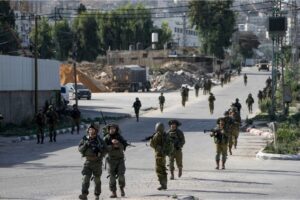
About the US military pier being built off Gaza coast
CNN reports: “Weeks of coordination and interaction with World Food Program (WFP), UN agencies that are responsible for security and other decision making, have all yielded a situation in which WFP will take on this work,” said one of the senior officials who spoke to CNN.
The UN and other aid groups initially did not necessarily want to be seen as partnering with an IDF operation in Gaza, the sources explained, and are also concerned for their safety, as IDF airstrikes have killed more than 200 aid workers since October 7.
“Everyone is wary of being too close to the IDF” for both security and political reasons, one humanitarian official told CNN.
US officials also told CNN that there has been concern in the region and at the UN that the pier operation will lessen pressure on Israel to keep the land corridors into Gaza up and running, which was the most efficient way of getting aid into the enclave prior to the war.
A spokesperson for the World Food Program said, “We can manage and receive assistance via a maritime corridor only if we can ensure that humanitarian principles are preserved, that we maintain our neutrality and independence, and that our staff can operate safely.”
Private company setting up parallel aid operation
At the same time, a private company called Fogbow, an advisory firm run by former US military and intelligence officials, is in the process of setting up its own maritime aid operation that will run parallel to — but separate from — the US military-led process, according to several people familiar with the plan.
People familiar with Fogbow’s plan say the firm has identified a construction company owned by a Palestinian-American with hundreds of trucks and a vast storage facility near Israel’s border to move the aid. Some aid groups would prefer all the distribution to be handled by the UN, and have raised concerns about the idea of concentrating so much power and responsibility into the hands of one wealthy Palestinian entrepreneur, whom sources identified as Bashar al Masri.
Scott Paul, the associate director peace and security at Oxfam, said that “what we don’t want is to create a parallel humanitarian system when we have one that could work without interference.”
“We particularly want to avoid creating a parallel humanitarian system if it is one that might at some point be leveraged to undermine the UN’s leadership role, or to expand permanent Israeli control in Gaza,” he said. “Those are the sort of the things that we are keeping an eye out for in all of this.” (Read the full article here.)
NOTE: Thousands of aid trucks are reportedly waiting at the southern border of Gaza, where Israel has made it extremely difficult to pass, employing complicated and arbitrary procedures; when aid has gotten into Gaza, the people have many times been shot at as they tried to obtain food. Israeli forces have targeted trucks themselves and humanitarian aid staff.
Humanitarian aid groups have said repeatedly that if Israel would cooperate at the border crossings, the people of Gaza would receive the aid they need, but the US has declined to put pressure on Israel to do so. Instead, these elaborate plans are in the works – as the people starve.
MORE NEWS
Middle East Eye: Outrage at Columbia University over censure of pro-Palestine professor Mohamed Abdou
Middle East Eye: “I miss school”: Israeli violence and closures force Hebron students into remote learning
Middle East Eye: How pro-Palestine artists are being cancelled by UK cultural institutions
IMEMC News Reports
⬅️شاهد ..
فيديو يوثق لحظة شن طيران الاحتلال غارة عنيفة على غزة خلال العدوان المتواصل pic.twitter.com/975afB0KwR— المركز الفلسطيني للإعلام (@PalinfoAr) April 21, 2024
Today, two-thirds of coordinated humanitarian missions in #Gaza were impeded or significantly delayed by the Israeli authorities.
On average, each of these missions faced nearly five hours of delay before being allowed to proceed. #AccessDenied
1/3 pic.twitter.com/9lizj9PCwa
— OCHA OPT (Palestine) (@ochaopt) April 20, 2024
For the first time since October, and with thanks to your support, our #Gaza team has been able to deliver food parcels to people driven from their homes by the Israeli military in the north.
Please continue to support our emergency response: https://t.co/PmYvdeWYuV pic.twitter.com/XCgOjJdzwm
— Medical Aid for Palestinians (@MedicalAidPal) April 20, 2024
STATISTICS OCTOBER 7 – APRIL 20:
Palestinian death toll from October 7 – April 20: at least 35,037* (34,543 in Gaza* (at least 14,560 children, 9,582 women), and at least 494 in the West Bank (117 children). This does not include an estimated 7,000 more still buried under rubble (4,900 women and children). Euro-Med Monitor reports 40,042 Palestinian deaths.
At least 42 Palestinians have died in Israeli prisons (27 from Gaza, 14 from West Bank)
At least 31 Palestinian children and several adults have died due to malnutrition**
About 1.7 million, or 75% of Gaza’s population are currently displaced.
About 1.1 million (out of total population of 2.3 million) are facing Catastrophic levels of food insecurity.
Palestinian injuries from October 7 – April 20: at least 81,664 (including at least 76,833 in Gaza and 5,000 in the West Bank).
It remains unknown how many Americans are among the casualties in Gaza.
Reported Israeli death toll from October 7 – April 20: ~1,407 (~1,139 on October 7, 2023, of which ~574 were civilians, 373 or 337 were security and/or military forces, ~32 were Americans, and ~36 were children); 259 military forces since the ground invasion began in Gaza;, 16 in the West Bank) and~8,730 injured.
Times of Israel reports: The IDF also listed 41 soldiers killed due to friendly fire in Gaza and other military-related accidents – nearly 16%.
NOTE: It is unknown at this time how many of the deaths and injuries in Israel on October 7 were caused by Israeli soldiers.
*Previously, IAK did not include 471 Gazans killed in the Al Ahli hospital blast since the source of the projectile was being disputed. However, given that much evidence points to Israel as the culprit, Israel had previously bombed the hospital and has attacked many others, Israel is prohibiting outside experts from investigating the scene, and since the UN and other agencies are including the deaths from the attack in their cumulative totals, if Americans knew is now also doing so.
**Euro-Med Monitor reports that Gaza’s elderly are dying at an alarmingly high rate. The majority die at home and are buried either close to their residences or in makeshift graves dispersed across the Strip. There are currently more than 140 such cemeteries. Additionally, according to Euromed, thousands have died from starvation, malnourishment, and inadequate medical care; these are considered indirect victims as they were not registered in hospitals.
Find previous daily casualty figures and daily news updates here.
For more news, go here and here. Broadcast news from the region is here.
Source: IsraelPalestineTimeline.org
- Genocide alert issued over Israeli violence in West Bank
- Blinken Is Sitting on Staff Recommendations to Sanction Israeli Military Units Linked to Killings, Rapes
- Leaked New York Times Memo Tells Journalists To Avoid Words “Genocide,” “Ethnic Cleansing,” and “Occupied Territory”
- U.S., Not Israel, Shot Down Most Iran Drones And Missiles
- Sorry, but Iran is not the aggressor here
- Mainstream U.S. media is hiding key truths in its coverage of Iran’s retaliatory attack
- Israel and US deliberately gutting international law in Gaza
- The growing panic about antisemitism isn’t a reflection of reality – The Forward
- Watching the watchdogs: Israel’s attacks on journalists are backfiring
- ‘Come out, you animals’: how the massacre at al-Shifa Hospital happened
- AIPAC Talking Points Revealed
- We Israelis are the biggest Holocaust deniers
- Freedom Flotilla Coalition to bring aid, international observers to Gaza this month
- Israel’s ‘Human Shields’ Lie Has Been Conclusively, Irrefutably Debunked
- 2024 spending bill disburses over $20 million per day to or because of Israel
- ‘Lavender’: The AI machine directing Israel’s bombing spree in Gaza
- Will the Israel Lobby Cause America’s Downfall?
- Israel Created ‘Kill Zones’ in Gaza. Anyone Who Crosses Into Them Is Shot
- Why AIPAC is still Israel’s foreign agent
- Hamas’s 2017 Charter: Full Text
- Israeli source of “executed children” lie admits story was untrue
- Another Israeli soldier admits to implementing the ‘Hannibal Directive’ on October 7
- Israeli General Admits War on Gaza Impossible Without US Support (video)
- UN Security Council says Yes to ceasefire; US abstains
- Israeli Soldier’s Video Undercuts Medic’s Account of Sexual Assault
- Report: Israeli forces strip, rape pregnant Gazan woman in public
- Pro-Israel Right Declares War on Candace Owen
- Be informed on things that matter: 6 recommended reads on Palestine & Israel
- It isn’t Netanyahu who is acting against the will of his people, it’s Biden
- Pramila Patten’s Rape Fantasies: A Critical Analysis of the UN Report on Sexual Violence during the 7 October Attack
- Here’s what Pramila Patten’s UN report on Oct 7 sexual violence actually said
- Will the Israel Lobby Cause America’s Downfall?
- Learn something new about Palestine and Israel this week – recommended reading
- An open letter to VP Kamala Harris on the occasion of her ceasefire speech
- Israel has lost control of the narrative – October 7 truths coming out
- Gaza Becomes Israel’s Testing Ground for US- and Israeli-made Military Robots
- Israeli rapes of Palestinian women and children, past & present
- NYT bombshell alleging Hamas sexual violence debunked once again
- Israeli newspaper: Israeli army ordered the killing of Israeli civilians and soldiers Oct 7
- Gaza’s chronically ill patients are out of medicine, doctors, and hope
- Ignoring Immolators Lulls the Society to Sleep: Aaron Bushnell at the Israeli Embassy: “FREE PALESTINE!”
- No Access, No Information: Thousands of Gazans “Forcibly Disappeared” by Israeli Forces
- “Anti-cancel-culture” Bari Weiss has a history of working to cancel voices she dislikes
- These Are the Jewish Megadonors Helping Fund Biden’s – and Republican Congress Members’ – Reelection Campaigns
- If you love babies, this is a must-read
- A wave of new post-Oct 7th “antisemitism” bills completely miss the point
- CNN staff say network’s pro-Israel slant amounts to ‘journalistic malpractice’
- Facts For Peace: the billionaire-backed campaign attacking the Palestinian cause
- Top military expert Col. Douglas MacGregor warns against attack on Iran (video)
- October 7th myths are still out there, killing Palestinians
- NYT: Where Is Hamas Getting Its Weapons? Increasingly, From Israel.
- 12 Essential Facts for Understanding the Current Israel-Gaza Violence
- Falk: Israel used Oct 7 attack as a pretext for its plan to expel Palestinians
- Synopsis of ICJ’s decision on Israeli genocide, reactions, and take-aways
- The West’s complete contempt for the lives of Palestinians will not be forgotten
- Israel has repeatedly rejected Hamas truce offers
- Why the Guardian’s ‘Hamas mass rape’ story doesn’t pass the sniff test
- Israel’s torture and humiliation of female and male Gazan prisoners
- Coverage of Gaza War in NYTimes & other major papers heavily favored Israel, analysis shows
- Two reports debunk New York Times ‘investigative report’ of mass rape on October 7th
- Israel’s Assault on Gaza Is Unlike Any War in Recent Memory
- US poised to give Israel $18 billion in aid this year
- Gaza Civilians, Under Israeli Barrage, Are Being Killed at Historic Pace

